Uplifting design: The office furniture made from wings, ailerons and even engines of decommissioned iconic war planes and jumbo jets
-
•Recycled parts of decommission planes including the Boeing 727 and C-119 turned into office tables and chairs
-
•Each piece of aviation history is custom-made by Californian design company MotoArt
-
•Some models, including the C-119 Rudder Desk, are limited edition because there are only 40 rudders left
PUBLISHED: 17:41, 16 July 2013 | UPDATED: 17:42, 16 July 2013
Add a little blue sky thinking to your office or business by installing a piece of aviation history to the boardroom.
A Californian company called MotoArt has come up with an uplifting solution for what to do with decommissioned aircraft - it turns them into eye-catching office furniture.
The craftsmen takes wings, spoilers, stabilisers, ailerons and engines from iconic planes such as the DC-4, the Boeing 727 and Boeing 747, C-119 and Albatross Aileron's and turns them into custom-made, glass-topped conference and office tables. The company also sells airplane seats.
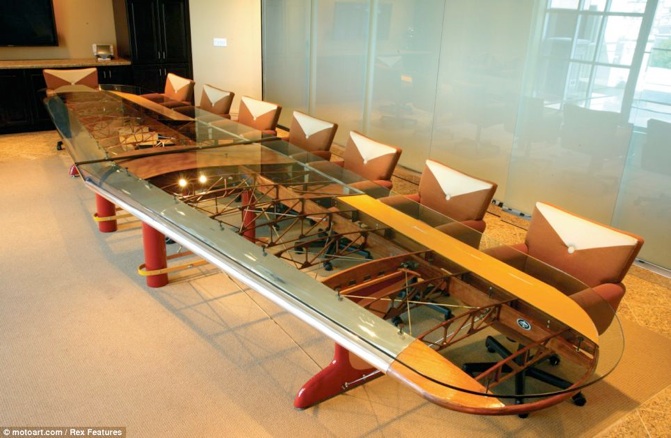
Motoart's newest Wing Conference Table, pictured, was created using parts from planes made by the Waco Aircraft Company. The company launched in 1920 with its initial floatplane design before launching open cockpit biplanes and later closed-cabin biplanes after 1930. Motoart's 1930 Waco Wing Conference Table has an art deco design and was crafted by hand. It was restored by Motoart and includes racing pant legs and glass to create the 24ft conference table
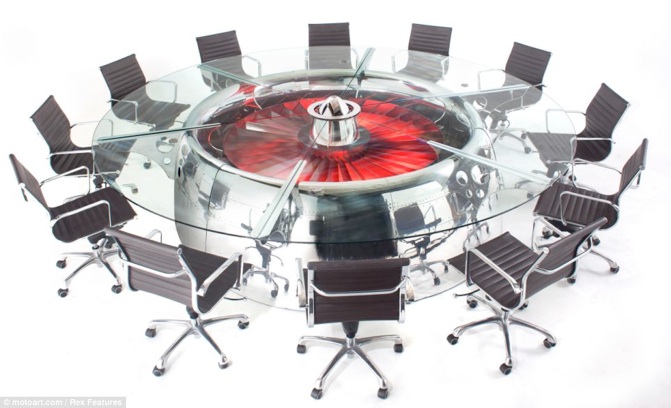
This conference room table was made using a General Electric engine nacelle from a Boeing 747. It's 12ft wide with a high-mirror polished table. The engine-cum-table seats up to 12 people and includes a set of six pop-up connection ports. The custom engine stator is fitted with internal LED lighting that can change colour and is topped with a B-52 engine spinner
One design sees a Boeing 747 jet engine cowling transformed into a conference table with room for twelve people around it.
Measuring 12ft across, the General Electric engine nacelle houses internal LED lighting in different colours as well as six pop-up connection ports,
The engine table is then topped with a B-52 engine spinner.
MotoArt's newest Conference Table was created using parts of the Waco Aircraft Company.
MotoArt's 1930 WACO Wing Conference Table has an art deco design and was crafted by hand.
It was restored by MotoArt, which also added racing pant legs and glass to create the 24ft conference table.
The Waco company launched in 1920 with its initial floatplane design before launching open cockpit biplanes and later closed-cabin biplanes after 1930.
Waco contributed to the war effort by producing large numbers of military gliders for the US Army Air Forces and the RAF. They were also used during the Normandy Invasion and Operation Market Garden and ceased trading after World War II.
Dave Hall of MotoArt Studios said: 'The 747 cowling conference table was design for a gas and oil company in Texas.
'The entire piece had to fit up an elevator to the 50th floor, so we had to design it to completely come apart.'
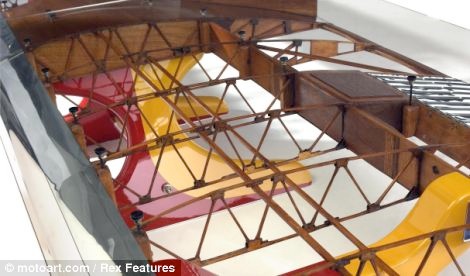
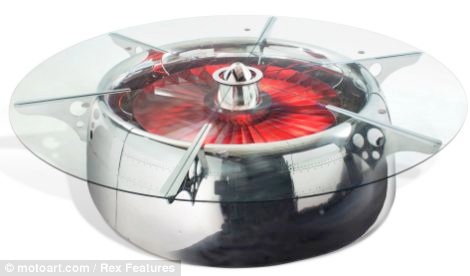
Write caption here
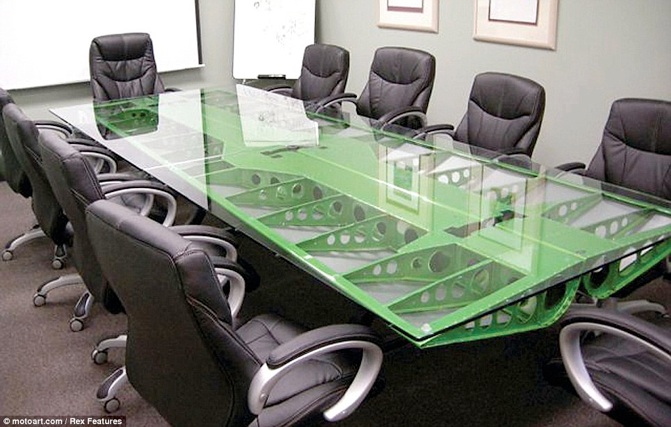
This table was made using two ailerons from a C-119 aircraft. The original cloth was removed and the two ailerons were tapered and assembled to provide extra leg space and fit inside 15ft-long conference rooms. The legs are made of bamboo and are custom made in the Motoart studio. They are designed to resist scuffing and can be painted any colour
Another eye-catching design includes the Lockheed V-Shaped C130 Conference Table.
It is shaped at an acute 17-degree angle and is made from two, 24ft-long full-length outer wing flaps of the C130 Hercules aircraft.
The 24-seater took 500 man-hours of 'painstaking attention to detail' and is used at Lockheed Martin headquarters in Arlington, Virginia.
The C130 Hercules aircraft line has the longest continuous production run of any military aircraft in history.
Originally designed as a cargo transport and medical evacuation aircraft for U.S. troops, the Lockheed C-130 was built at the request of the U.S. Air Force and originally named the C-130 Hercules.
On 23 August 1954 it took off on its inaugural flight and went from Burbank, California to Edwards Air Force Base.
The C-130 was converted into over 40 different versions including the AC-130 gunship, also known as Fat Albert.
Other highlights include a C-119 Aileron conference table that can be cut to size.
The original cloth was removed to show the skeletal structure underneath and the two ailerons were tapered and assembled to provide extra leg space and fit inside 15ft-long conference rooms.
The legs are made of bamboo and are custom made in the MotoArt studio. They are designed to resist scuffing and can be painted any colour.
Topped off with a tempered glass sheet, a corporate logo can be added to the underside of the table.
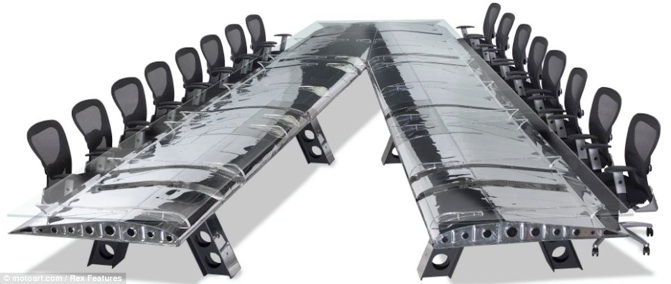
Another eye-catching design includes the Lockheed V-Shaped C130 conference table. It is shaped at an acute 17-degree angle and is made from two, 24ft-long full-length outer wing flaps of the C130 Hercules aircraft. The 24-seater took 500 man-hours of 'painstaking attention to detail' and is used at Lockheed Martin headquarters in Arlington, Virginia.
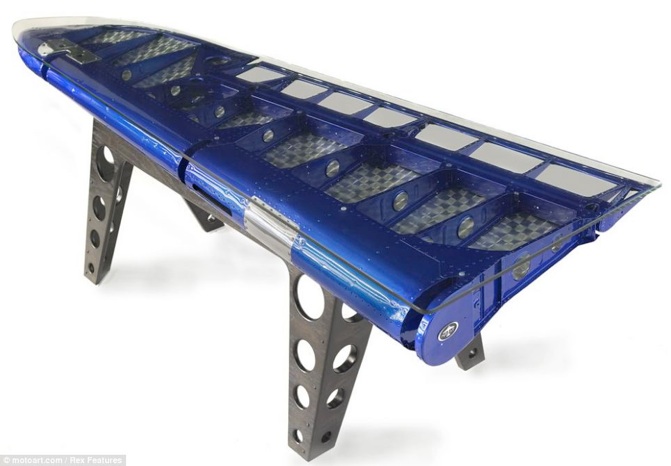
The Fairchild C-119 rudder desk, pictured, is a limited-edition model and Motoart has only made 40 frames available. The original cloth cover on the 1950's rudder was removed and the rudder was mounted on a 4ft hardwood V-shaped legs. This desk measures 8ft 4in, or it can be customised to an extended length of 11ft if used as a conference table
MotoArt craftsmen spent over 160 hours stripping the original cloth, cutting, patching, grinding and sanding the part's aluminum.
The underside of the table can be fitted with optional decorative aluminum to obstruct the view of the floor, as well as portholes for telephone, computer or video cables.
The Fairchild C-119 rudder desk is a limited-edition model and MotoArt has only made 40 frames available.
The original cloth cover on the 1950's rudder was removed and the rudder was mounted on hardwood V-shaped legs.
This desk measures 8ft 4in, or it can be customised to an extended length of 11ft if used as a conference table.
Known as 'The Flying Boxcar' the C-119 was used as a cargo plane was built between 1947 and 1955, originally replacing the C-82 'Packet'.
Deployed during the Korean and Vietnam Wars, the C-119 began as a troop and cargo hauler but was later fitted with weapons.
The AC-119G 'Shadow' sported infra-red technology, armour plating, fire launchers and mini-guns.
The Shadow was later upgraded to the AC-119K 'Stinger' and was outfitted with turbo-jet engines.
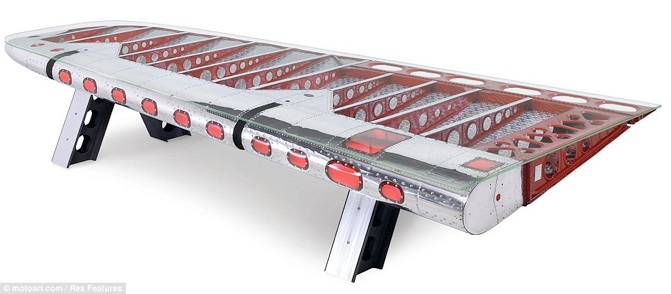
The DC-4 Conference Table, pictured, is made from the wing of the 1930's aircraft. It is 14ft and has a mirror polished edge. The table comes with red LED lighting and the dual aluminium I-Beams are fused together, powder coated, and completed with polished aluminum end caps
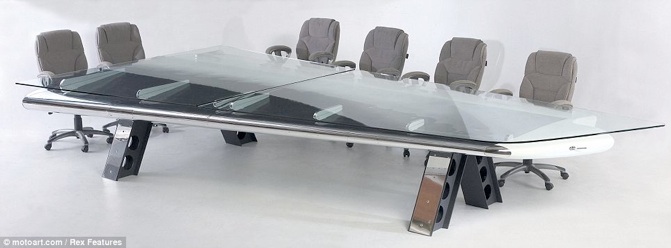
Built from the horizontal stabiliser of the Boeing 727, the 727 Conference Table, pictured, has an aluminum frame and anodised I-Beams. MotoArt strips the stabiliser of all impurities, before cutting, grinding, sanding and polishing it. The piece can be cut to lengths from 15ft and additional holes can be cut through the table for phone and computer cables
Additionally, the C-119 was deployed for aerial recoveries and the plane holds the world record for the first successful recovery of film from an orbiting satellite.It also was the first aircraft to perform an airborne film recovery from an object returning from Earth’s orbit.
After the Vietnam War, the C-119’s were used by the U.S. Forest Service to battle wildfires.
In 1987, after a series of crashes, the C-119 was deemed too dangerous to fly and all planes were taken out of service.
The DC-4 Conference Table is made from the tip of the wing from the 1930's aircraft.
It is 14ft and has a mirror polished edges with a powder coated treatment in the choice of the customer's choice.
The table comes with red LED lighting and the dual aluminium I Beams are fused together, powder coated, and completed with polished aluminum end caps.
The DC-4 took its inaugural flight on 7 June 1938 and was built as a compliment to the DC-3.
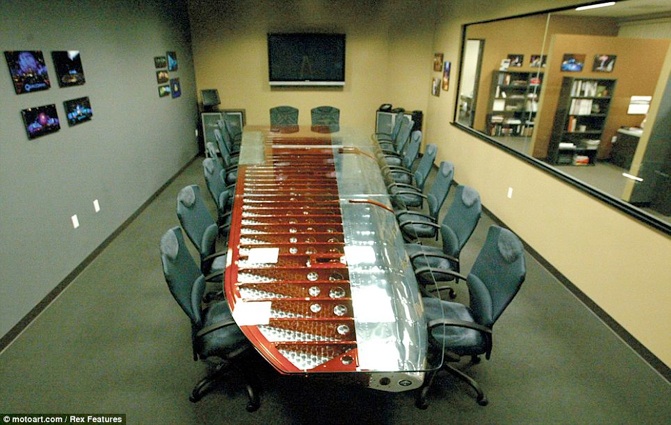
The MotoArt Albatross Aileron Conference Table, pictured, comes with a right and left wing decommissioned stabiliser from the historic Grumman amphibious flying boat. The ailerons can be cut to any size from 8 to 18 feet, and is 60ft wide. Both wing Albatross ailerons have a turned aluminum under paneling. The custom made bamboo hardwood base can be stained or painted and the table can be outfitted for voice, power or data ports.
Fulfilling United Airlines’ request for a long range passenger plane, the DC-4 was shifted to combat service during the war and was renamed the C-54.
One of the C-54’s most notable missions was the Berlin Airlift where it operated alongside the C-47 to lift 5,000 tonnes of supplies into war-torn Berlin.
The DC-4’s four wing engine design meant the plane could fly even if two of the four engines failed, and could maintain an altitude of over 5,000 feet with three engines down.
Built from the horizontal stabiliser of the Boeing 727, the 727 Conference table has an aluminum and anodised I-Beams with lightness holes.
MotoArt strips the stabiliser of all impurities, before cutting, grinding, sanding and polishing it. The piece may be cut to lengths from 15ft and additional holes can be cut through the table for phone and computer cables.
The first B-727 took its maiden commercial flight on 9 February 1963 for United Airlines.
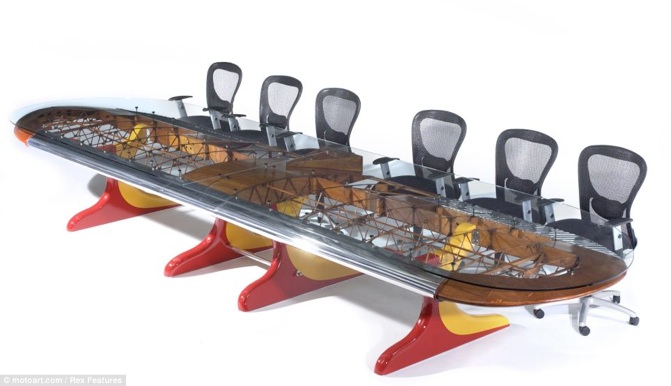
The Waco Aircraft Company, which sold parts for this conference table, contributed to the war effort by producing large numbers of military gliders for the US Army Air Forces and the RAF. They were also used during the Normandy Invasion and Operation Market Garden and ceased trading after World War II
The triple engine design made the smaller aircraft better suited for smaller landing strips and airline routes with smaller passenger demands.
The 727 could also fly overseas and into higher altitude cities than the B-707. Since the B-727 was made for smaller airports, the plane needed to be serviceable quickly from the ground so an 'airstair' was designed allowing access to the cabin.
MotoArt spends 140 hours making this airplane conference table, and it can be bought with airplane seats.
The MotoArt Albatross Aileron Conference Table comes with a right and left wing decommissioned stabiliser from the historic Grumman amphibious flying boat.
The ailerons can be cut to any size from 8 to 18 feet, and is 60ft wide.
Both wing Albatross ailerons have a turned aluminum under paneling and the custom-made bamboo hardwood base can be stained.
The table can also be fitted for voice, power and data ports.
MotoArt owner Dave Hall said: 'If you can imagine it, we can do it. We can add portholes for telephone, computer or video cables, or perhaps you’d like a glass riser added to the middle of the table for video monitors.'
The prices for each of the individual tables vary depending on the custom elements added or taken away and quotes can be obtained from the MotoArt website.